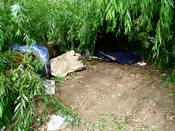Introduction
Homelessness is a social problem in Australia. Youth homelessness in Australia has been on the increase due to several factors, and it is assumed that these factors may assist in the intervention and prevention of youth homelessness. The only way to decrease youth homelessness is to address the structural factors that cause it. This paper will begin by defining homelessness according to the Supported Accommodation Assistance Act 1994 and by other prominent authors of youth homelessness. Structural factors will be then discussed, including unemployment and lack of affordable housing, as prominent causes for the increase in youth homelessness. It will be argued that the Australian 'nuclear' family has changed since the 1970's and has contributed to why some individuals or families face homelessness more than others. Government responses to youth homelessness, especially after the release of the Burdekin Report, will be examined, specifically the Supported Accommodation Assistance Program (SAAP) and the Reconnect Program.
SAAP, being the primary focus, will be examined to determine whether the program is adequate in breaking the homelessness cycle.
Crane & Brannock (1996, p. 7) argue that the way in which homelessness is defined affects the way research is carried out and what policies are pursued. What is homelessness? Homelessness is defined in terms of the character of a person's housing situation and adequacy (Crane & Brannock, 1996, p. 6). This definition is backed up by the Supported Accommodations Assistance Act 1994 that states that a 'person is homeless if, and only if, he or she has inadequate access to safe and secure housing' (S. 4.1 ). There are a variety of factors that contribute to the cause of homelessness amongst young people. Various studies have been initiated to investigate these factors to develop prevention and intervention strategies for youth homelessness. The most prominent of...


